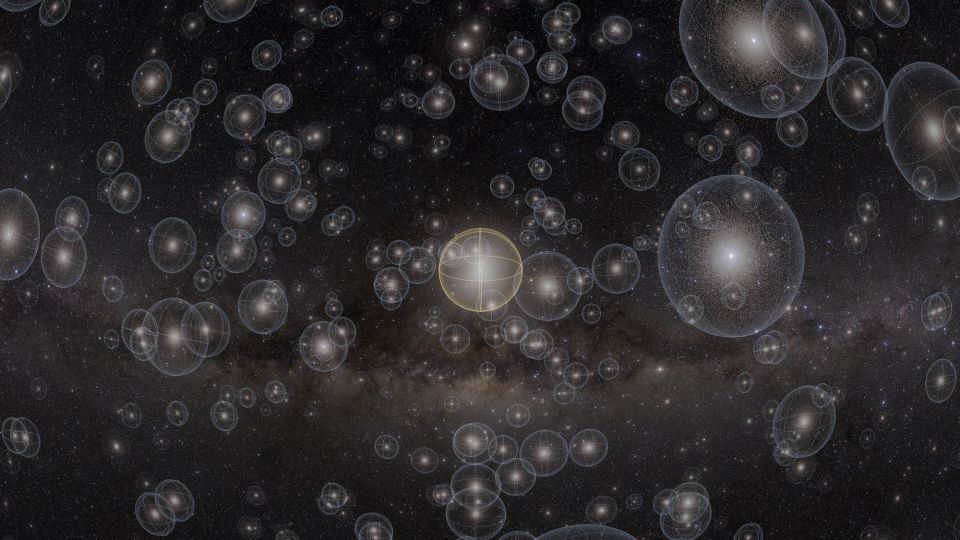
An unexpected discovery at the Hayden Planetarium in New York City may fundamentally alter our understanding of the solar system’s most enigmatic structure, the Oort Cloud. During a preproduction test for the show “Encounters in the Milky Way,” which premiered on Monday, a projection revealed a spiral formation within the Oort Cloud, challenging the long-held belief that it is spherical.
The Oort Cloud, an expansive region of icy bodies orbiting the sun at a distance 1,000 times greater than Neptune, has never been directly observed. However, this accidental revelation during the show’s production has sparked intrigue among scientists. Jackie Faherty, an astrophysicist at the American Museum of Natural History and the show’s curator, expressed her initial confusion upon witnessing the spiral structure projected on the planetarium’s dome.
A Serendipitous Discovery
Faherty reached out to David Nesvorny, a scientist at the Southwest Research Institute in Boulder, Colorado, who had provided the scientific data for the scene. Initially suspecting a visualization artifact, Nesvorny confirmed the spiral’s presence after reviewing his data. He subsequently published a paper on the discovery in The Astrophysical Journal.
“Weird way to discover things,” Nesvorny remarked. “I should know my data better, after years of working with it.”
The Oort Cloud was first theorized by Dutch astronomer Jan Oort in 1950 as a shell of icy bodies surrounding the sun up to 1.5 light-years away. This distant region, composed of solar system remnants, is believed to stretch halfway to the next star, according to NASA. The cloud’s bodies, scattered in all directions, travel on varied inclinations, contributing to the spherical depiction.
Unveiling the Spiral
The spiral was hidden in Nesvorny’s data because it had not been visualized in three dimensions. Once examined in Cartesian coordinates, the spiral became evident. To validate the findings, Nesvorny employed NASA’s Pleiades Supercomputer, running simulations that confirmed the spiral’s existence across various models.
“I thought, maybe just this particular simulation is showing it, and all the other simulations with other stellar encounters, other parameters, will not show it,” Nesvorny explained. “But all the simulations, all the models I have, show the spiral.”
The spiral’s presence is attributed to the galactic tide—the gravitational pull of the Milky Way’s stars and dark matter—affecting the Oort Cloud’s small bodies and comets. This gravitational influence twists their orbits into a spiral shape, particularly in the inner Oort Cloud.
Challenges in Observation
Despite the discovery, observing the Oort Cloud remains a challenge. The Vera C. Rubin Observatory in Chile, with its powerful telescope, may aid in identifying individual icy bodies within the cloud. However, as Nesvorny noted, the telescope might only discover dozens of these bodies, insufficient for a comprehensive visualization of the spiral.
Faherty highlighted the significance of understanding the Oort Cloud’s structure in theories of solar system evolution. She posited that comets from the cloud might have delivered water and life’s building blocks to Earth, emphasizing the need to comprehend its shape.
“If you’re going to come up with a theory of how solar systems evolve, you should take into account the kind of shapes you might have in their structure,” Faherty stated.
Implications for Astronomy
The spiral discovery exemplifies the potential of visualizing the universe in novel ways, according to Malena Rice, an assistant professor of astronomy at Yale University. She noted that this finding reshapes our perception of the solar system and provides insights into extrasolar systems’ Oort clouds.
“This result reshapes our mental image of our home solar system, while also providing a new sense for what extrasolar systems’ Oort clouds may look like,” Rice said.
However, the theoretical nature of the paper, based on numerical simulations, presents challenges for confirmation. Edward Gomez, an astrophysicist at Cardiff University, pointed out that only a few potential Oort Cloud objects are known, complicating the testing of the spiral model.
Simon Portegies Zwart, a professor at Leiden University, expressed skepticism about witnessing the spiral in the near future. While the Vera Rubin Observatory may detect more inner Oort Cloud objects, a clear detection of the spiral remains unlikely without significant discoveries.
“It is interesting that they found the spiral, but it seems unlikely that we are going to witness it in the foreseeable future,” Zwart commented.
As scientists continue to explore the mysteries of the Oort Cloud, this accidental discovery serves as a reminder of the dynamic and interconnected nature of our solar system within the broader galaxy.






